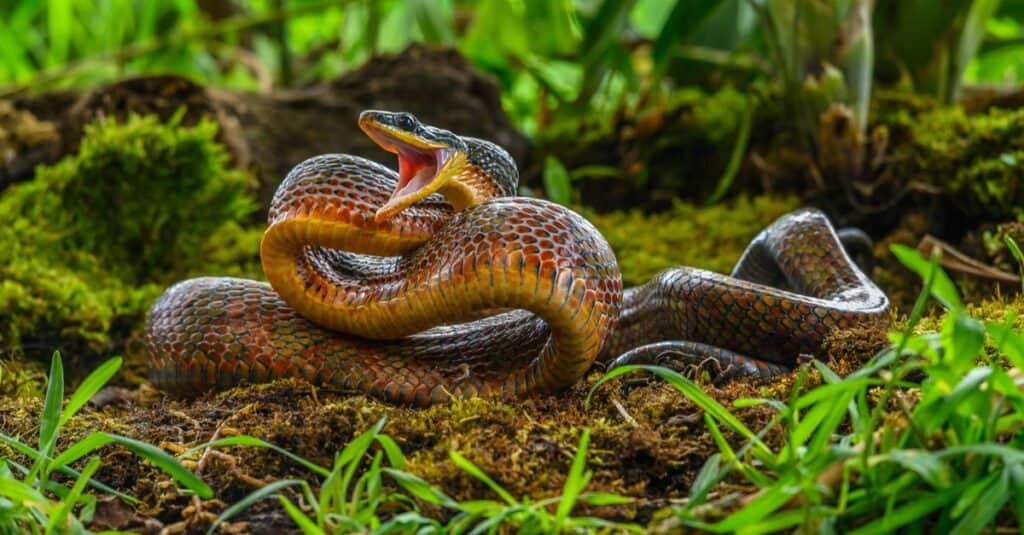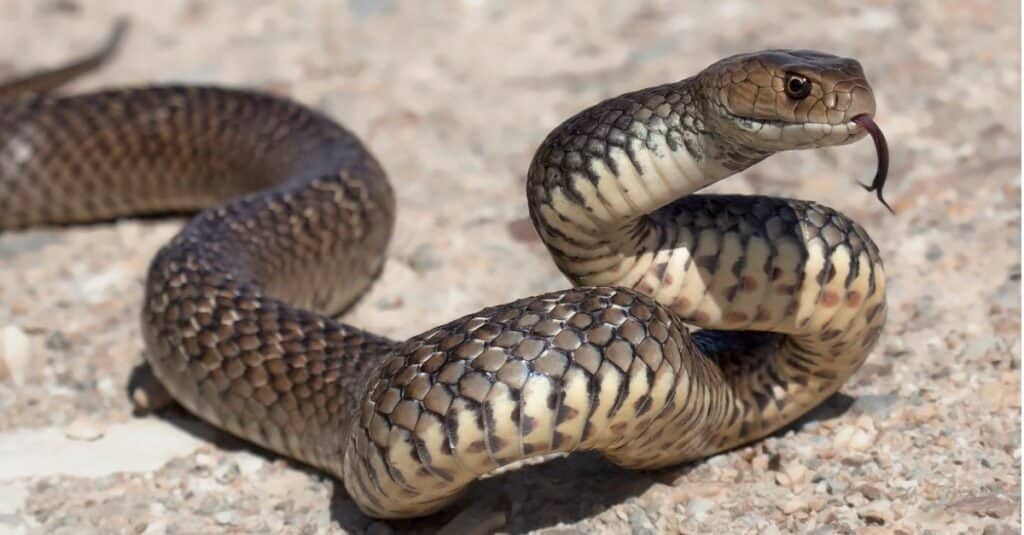Snakes are reptiles. They are not mammals. Mammals have hair or fur, while snakes are covered with overlapping scales. Mammals are warm-blooded, which means their bodies regulate their own heat. Snakes are cold-blooded, which means the heat of their bodies is regulated by their environment. But the thing that really separates mammals from snakes is that mammals have mammary glands used to nurse their young while snakes do not nurse their young and lack this anatomical feature.
Snakes also lack limbs that all mammals have, even if a few species have limbs that evolved into flukes and flippers, such as those of sirenians or cetaceans. Though reptiles are older than mammals, snakes are younger than mammals, having evolved from lizards only about 143 to 167 million years ago. Mammals diverged from reptiles over 200 million years ago.
While snakes and mammals have seemingly little in common, they actually share ancestors, both evolving from ancient reptiles. Yes, mammals evolved from reptiles, specifically the reptilian order Therapsida, over 200 million years ago. Theraspids are one of the earliest known reptilian groups and over time evolved from primarily predation to herbivory as well. Their dentition also evolved into heterodontism, teeth separated into categories of molar, incisor, or canine, similar to mammalian dentition. Mammals also retain other traits from their reptilian ancestors, such as an efficient four-chambered heart, an airway that allows them to breathe and eat simultaneously, and hair, correlating to endothermy (warm-bloodedness). The evolution from reptile to mammal was not linear and involved what is known as a “mosaic” pattern of evolution, meaning at any point in time animals existed with characteristics of both reptiles and mammals, hybrids, if you will.
Like mammals, some reptiles experience live birth, having incubated and hatched their eggs internally, and protecting their babies for a short while. The king cobra mother is the only snake known to build a nest. Still, no snake nurses its young. Many mammal babies are also born underdeveloped and helpless, while baby snakes are ready to care for themselves the moment they enter the world. Some snakes, like baby king cobras, are as or more venomous than their parents.
Venom is another thing that separates snakes from mammals, though there are some exceptions. While most of these reptiles do not have venom, there are many that do. Some have venom potent enough to kill a human. However, venomous mammals do exist, including the solenodon and the northern short-tailed shrew. The male platypus, a supremely fascinating mammal in several ways, contains venom in spurs on the backs of the feet. The slow loris of Southeast Asia is believed to be the only venomous primate.

©Vaclav Sebek/Shutterstock.com
Are Snakes Endangered?
About one in nine snake species is endangered due to pollution, climate change, needless killing, and habitat destruction. Some people kill them whenever they encounter them, which is foolish because snakes eat mice, rats, and other vermin. Some of these endangered reptiles include:
- Round Island boa. This constrictor, found only on Round Island in Mauritius, is considered vulnerable.
- Antiguan Racer. This creature, endemic to Great Bird Island in the Caribbean is critically endangered.
- Zong’s Odd-scaled Snake. Found in China’s Jinggang mountains, this glossy blue-black animal is also critically endangered.
- Seychelles House Snake. Found in the tropical and subtropical forests of Seychelles, this snake is also endangered, and its numbers are decreasing.
- Plain Mountain Adder. This adder is found in South Africa’s Cape Province and is considered vulnerable.
- Philippine Common Cobra. This cobra is near threatened.
- Bardick. This Australian reptile is also near threatened.
Where do snakes live?
They live on all the continents save Antarctica and a handful of islands. There are no snakes native to Ireland, not because St. Patrick kicked them out but because they were never there in the first place. They’re also not found in Hawaii, New Zealand, Greenland and Iceland.
As cold-blooded animals, they are also scarce in places with harsh winters such as northern Russia and Canada. They live on land and in the waters of the Pacific and Indian Oceans, where they are called sea snakes. Like cetaceans, which are mammals, these animals live their whole lives in the water but must come up for air. They have adapted to the ocean environment by evolving a compressed body and a tail shaped like a paddle.
Why are some snakes venomous?
Scientists believe that venom developed in these reptiles to help them subdue and digest their prey, and its use in self-defense was an afterthought. Venom in snakes is a type of supercharged saliva, and one of the purposes of every animal’s saliva is to start the digestive process. Some snakes deliver venom through hollow fangs at the front of their mouth, while others deliver it through grooved fangs at the back, such as the boomslang. The gaboon viper is believed to have the longest fangs of any snake at about 2 inches. Happily, this creature is fairly docile.

©iStock.com/KristianBell
Are snakes dangerous?
Though most snakes are nonvenomous, there are a few that are extremely dangerous and should really be left alone if they are encountered. According to the World Health Organization, every year 81,000 to 138,000 people die after being bitten by a snake out of 5.4 million people being bitten overall. The chief culprits when it comes to dangerous snakes include the king cobra, the inland taipan, the black mamba, the puff adder, and the saw-scaled viper.
Venom evolved to help subdue and predigest prey and not to kill or injure humans, but it can still devastate human bodily systems. The venom of the king cobra destroys living cells and attacks the nervous and cardiovascular systems. Rattlesnakes have venom that mainly attacks the blood’s ability to clot and causes sometimes life-threatening necrosis.
It must also be said that even non-venomous snakes like the black racer can be mean-tempered and deliver a nasty bite. In that case, the person should carefully clean the wound and get a tetanus shot. If you’re not sure if the animal is venomous or not, seek medical help.
Next Up: Are Penguins Mammals?
The photo featured at the top of this post is © Kurit afshen/Shutterstock.com
Discover the "Monster" Snake 5X Bigger than an Anaconda
Every day A-Z Animals sends out some of the most incredible facts in the world from our free newsletter. Want to discover the 10 most beautiful snakes in the world, a "snake island" where you're never more than 3 feet from danger, or a "monster" snake 5X larger than an anaconda? Then sign up right now and you'll start receiving our daily newsletter absolutely free.
FAQs (Frequently Asked Questions)
What kind of reptile is the snake?
All extant snakes belong to the Serpentes suborder, which is part of the Squamata order. Squamata is the largest order for reptiles and contains snakes, lizards and creatures called worm lizards. Snakes also belong to two infraorders, Alethinophidia and Scolecophidia, which are further divided into families, genera and species.
How many species are there?
There are about 3900 species of snake.
Why isn’t a glass lizard a snake?
There are several reasons why a glass lizard, which is a legless lizard that can be easily mistaken for a snake, isn’t a snake. As a lizard, it has eyelids and can blink. Snakes don’t have eyelids. It also has tiny earholes, while snakes do not. Glass lizards can’t unhinge their jaws, so they are confined to prey smaller than their head. A glass lizard can also detach its tail without much damage to itself. When a would-be predator grabs it by its tail, the tail just breaks off while the rest of the lizard gets away. Sometimes the tail even shatters into pieces, which gives the lizard its “glass” moniker.
Are they omnivores, herbivores or carnivores?
Snakes are carnivores. They either kill their prey through envenomating it, squeezing it to death in their coils or eating it while it’s still alive. Because snakes can’t chew but can basically unhinge their jaws, they swallow their prey whole. One exception to this may be the water moccasin found in the southern United States. This animal has been known to eat carrion.
How long can they live?
The lifespan of a snake depends on its species. Generally, if it avoids humans and other threats it can live about 20 to 30 years on average. Snakes that are kept in captivity and are well cared for live longer. For example, the southern copperhead of the United States can double its lifespan of 15 years if it’s in captivity. The ball python probably has the longest lifespan of any snake. It can live between 20 and 40 years.
Do they make good pets?
There are some that do make good pets, especially if the owner doesn’t mind the lack of cuddliness. Snakes that are kept as pets include garter snakes, smooth and rough green snakes, the milk snake, ball and children’s pythons, the corn snake and the rainbow boa.
Thank you for reading! Have some feedback for us? Contact the AZ Animals editorial team.






